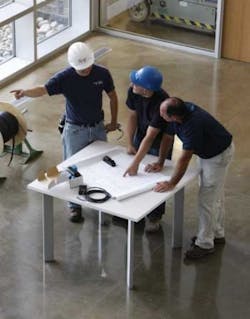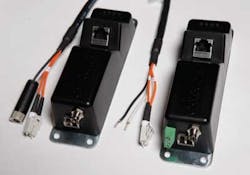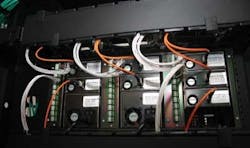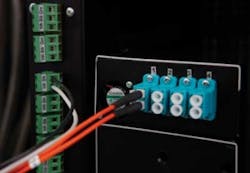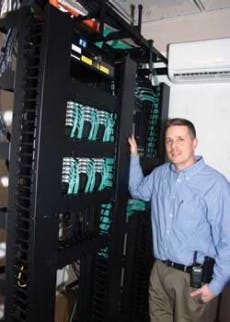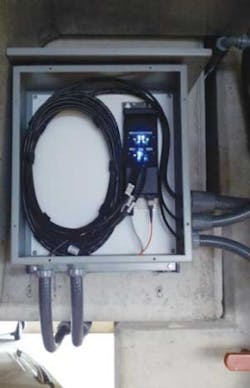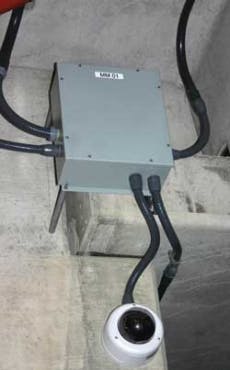Extending PoE long distances for safety's sake
Hudson Valley Community College used a rugged system to power cameras in its new parking garage.
Carol Everett Oliver, RCDD, ESS
Safety is a top priority on all college campuses. Colleges and universities are mandated by local governments to provide crime statistics to their communities for every two-year period. A safe and secure environment can be achieved through the cooperation of the community combined with investment by the college in safety measures, such as access control and security systems that are efficiently monitored.
Hudson Valley Community College (HVCC; www.hvcc.edu) in Troy, NY prides itself on its safe environment and respectable track record. So when the college faced constructing a new parking garage, it wanted to make sure all precautions were taken by installing the most-advanced surveillance system, which included high-resolution Internet Protocol (IP) cameras. HVCC also wanted the cameras to be powered through Power over Ethernet (PoE) to assure reliability, even during power outages, as all network equipment is backed up by uninterruptible power supply (UPS) systems through the college-managed electrical plant.
A technician pulls the copper/fiber composite cable that is part of the OneReach System from Berk-Tek. The company says the composite cable saves installation time and costs by allowing optical fibers and copper conductors to be installed with a single pull.
The biggest dilemma, however, was finding a rugged PoE cabling system that could extend to distances more than 100 meters from the telecommunications room (TR), located on the bottom floor of the garage, and to cameras located on all five floors. After reviewing several product options the college selected a copper/fiber composite cabling system–OneReach from Berk-Tek, a Nexans company.
Cabling distances and power options
During the project's planning stages, the first step was to determine camera locations and camera types, to assure all areas of the parking garage could be constantly viewed. The engineers determined that a total of 55 cameras would be required, which would include 2 cameras dedicated to license-plate reading at the entrance/exit, 4 interior cameras for the office and walkways, and 49 outdoor cameras. The cameras would be mounted on the ceilings of the four floors but the rooftop parking area would require cameras on poles.
"For most of the camera locations, we selected Pelco's IP110 Camclosure indoor/outdoor mini-dome cameras as they are weatherproof, tamper-resistant, fit into multiple mounting options and offer low-light sensitivity with high resolution, which was perfect for our garage environment," notes Robert Kwiatkowski, senior network specialist II for HVCC. These Pelco (www.pelco.com) cameras have a built-in 100Base-TX network interface for live streaming to a standard Web browser or to Pelco's Endura Enabled software system. For the pan/tilt/zoom (PTZ) cameras, HVCC also selected cameras from Pelco. The Spectra IV IP PTZ dome cameras allow both control and monitoring over the IP network from any location that is tied to the campus network.
Crew members from Adirondack Cable plan the installation of the OneReach cable system with a member of the information-technology team at Hudson Valley Community College.
"Running Power over Ethernet to IP cameras is customarily done over twisted-pair cable, but we had two main issues we were facing during the design stage," states Kwiatkowski. "The first issue was the distance and the second was that copper can act like an antenna for lightning. And we certainly didn't want the voltage to backflow into the TR." HVCC also needed to power the cameras and keep the data and power cables in separate pathways.
The OneReach System includes composite cable manufactured by Berk-Tek and media-conversion technology from Fiber Connections Inc.
Currently no standards address this type of setup so the information technology (IT) team at HVCC explored various options. The obvious available solution was to run fiber to the cameras and use media converters with patch cords terminating into the cameras. A second option was to install large outdoor-rated junction boxes and install a hardened PoE switch. This option would require hardened UPS units as well, which would mean installing larger boxes to handle the power units. The first option looked like the only viable choice, but the college had concerns about media converters' electronics costs as well as logistics for terminating the media converters in a protected junction box. Additionally, there had to be a way to ground and power the devices at the remote site.
Uniform campus cabling
Another factor in the cabling dilemma was that the IT department wanted to maintain consistency in the cable plant for all its networked applications–data, voice and security. In 2006 the entire campus infrastructure had been revamped and brought up to date. At that time HVCC selected the NetClear GT2 Category 6 solution from Berk-Tek and Legrand|Ortronics (www.ortronics.com) for its data and voice cabling infrastructure.
Prior to the 2006 cabling-renovation project, HVCC had reviewed several solutions through a rigorous process of comparing specs and testing actual cable and connector samples. Kwiatkowski recalls, "In some cases, we were experiencing a 30 percent failure rate with the patch cords. That was unacceptable for our over-2,000 campus drops. We have 8,000 patch cords between the equipment and outlets and have not had one failure with the NetClear solution." The NetClear solution comprises Berk-Tek's LANmark-1000 Category 6 horizontal cable terminated to Legrand|Ortronics Clarity 6 connectivity hardware including patch panels, patch cords and outlets.
The data outlets are located in labs, offices and at students' desks. Only equipment maintained by HVCC can be connected to the wired network. A separate wireless network enables the 14,000 enrolled students to gain Internet access outside of the campus network using personal devices.
Selecting a cabling system for the Pelco IP cameras meant terminating these cameras into the HVCC network equipment. During the design stage the IT department turned to Berk-Tek for a solution that would fit into the existing cabling plant. "Timing was perfect since Berk-Tek had just introduced a copper/fiber composite cable that could extend PoE and data capability farther than the 100-meter distance limitations of copper twisted pair," states Mike Connaughton, RCDD, fiber-optic product manager for Berk-Tek.
Integrating IP into the network
The Berk-Tek composite cable is a Class 3 riser-rated copper cable, with optical fiber. This cable can transmit Ethernet data through the fiber strands and power through the copper conductors. Depending on the distance to the end device, the gauge of the multiple copper strands can be specified from 12 to 18 AWG. The outer jacket is water-resistant and the inside is also water-blocked with a patented dry powder coating called DryGel. The cable, when combined with media converters developed by Fiber Connections Inc. (www.fiberc.com) creates a total system called OneReach.
The media-converter set includes a powered transmitter, known as a power-injector module, at the TR end and a receiver/optical-electrical converter, known as remote PoE ports, at the device end. The media converters are available as one- to four-port modules and can be rack-mounted in the TR. Through an RJ-45 patch cord in the TR the system is connected to a switch. On the device end, an RJ-45 patch cord or an additional 300 meters of solid-conductor UTP cable connects the media converter to the end device to deliver both data and power. Through this system, Power over Ethernet (IEEE 802.3af) can now be extended well beyond 1,000 meters–more than 10 times the distance of a UTP channel. "One of the biggest advantages of this system is that unlike typical media converters, the device-end media converter does not require separate power; significant savings are realized in both electrical materials and labor," states Geoff Laycock, vice president of sales and marketing with Fiber Connections.
The Power over Ethernet media modules are rack-mounted in the telecommunications room and are available with one to four ports apiece.
The original plans included a remote PoE port assembly at each camera location. This would have entailed 49 different cables and media modules to the 49 camera locations using the OneReach cable assemblies, and would have created a pathway nightmare. Because the media converters are available with multiple ports, HVCC was able to consolidate its requirements to 14 multi-stranded composite cables, each consisting of 8 fibers and 3 copper strands to deliver power. From multiple 4-port power-injection devices in the TR, which were rack-mountable units housed in data racks and attached to the switches, the cable assemblies were then terminated to corresponding 4-port remote units located in 14 strategic locations.
From the composite cable, the copper conductors (left) and the optical fibers (right) are terminated within the parking garage at Hudson Valley Community College.
Because of the weather extremes in Troy, NY, careful selection of the conduit and enclosure boxes at the termination end, where the media converters would be housed, became critical. "In selecting the steel enclosures, we needed to look at the size of the box as well as the NEMA rating to sufficiently house the converter and a service loop of cable, making sure that there would not be a problem of overheating in the confined space," explains Kwiatkowski. The service loop consisted of 5 to 6 feet of the Category 6 cable for future use, or for potential later relocation of the cameras.
Cabling installation challenges
To make the installation easier the CL3R-OF composite cable was carefully measured from the TR to each device-end termination point, and then order as preterminated cable from Anixter (www.anixter.com), HVCC's selected local distributor.
"Preterminated cable saves a lot in installation time and labor since the cable arrives pretested and preterminated, so it is a plug-and-play scenario," says Connaughton.
"The most laborious task of ordering preterminated cable is measuring and remeasuring the lengths," comments Kwiatkowski. "We had an estimate of lengths, but we used mule tape with units of measurement through the conduits, after they were installed by Justin Electric, to reconfirm the exact lengths."
Robert Kwiatkowski, senior network specialist II with Hudson Valley Community College, is shown here in one of HVCC's telecom rooms. Kwiatkowski explains that measuring and remeasuring circuit lengths was the most laborious part of ordering the preterminated cabling system.
Adirondack Cable, the selected cable installer, devised a unique "top-down" approach to pulling the cable and terminating it into the media converters in the NEMA enclosures and then into the TR, located on the first floor near the indoor guard station and monitors. All the cable was pulled from the third floor, through the conduits and dropped to each enclosure. Cables for the cameras on the fourth and fifth levels were pulled up through the conduits from the central pulling location.
The composite cables were terminated into the media converters in the TR and to the four-port media converters at the remote enclosure locations. In an attempt to protect the media modules and network from lightning, the Category 6 cable connecting the camera to the remote media converter used surge protection from Ditek Corp. (www.ditekcorp.com). From the enclosure, Berk-Tek LANmark 6 outside plant cable was pulled to each camera and directly terminated.
"In structured cabling practices a workstation outlet and patch cord is recommended. But due to the lack of room in the conduit and security of the camera connection, we opted to attach a plug directly to the solid conductor cable," explains Kwiatkowski.
Shown here is the inside of a steel enclosure within the HVCC garage.
"We call this 'direct-attach.' Berk-Tek is the only cable manufacturer to provide a warranty for these links," notes Connaughton. "This practice is actually recognized in the TIA-862 standard for building automation systems, and is being reviewed by draft ANSI/BICSI ESS standards, but for now this practice is not a commonality. It will become adopted as more and more IP devices get added to the network and does not follow typical premises installation routines since the collocation of the termination points will vary, depending on the application, such as security cameras or access points."
The Berk-Tek OASIS warranty covers all the cable and termination for 15 years if installed by a certified OASIS installer, which Adirondack Cable is, and meets all recommended procedures and provides test results.
"For extra cable protection, cable management and administration, we used horizontal wire managers in the TR to protect the cable," notes Kwiatkowski. In meeting the requirements for the ANSI/TIA-606-A Administration Standard for Telecommunications Infrastructure, unique identifiers are associated with each element of the infrastructure. These identifiers are key to finding the recorded information within the administration system selected throughout the infrastructure's life. "We made sure that each port, cable, enclosure and chassis were well-labeled, to simplify any future troubleshooting if needed," states Kwiatkowski.
In the parking garage, NEMA-rated steel enclosures house media-conversion equipment as well as service loops of cable. When selecting the enclosures as well as conduit, HVCC had to consider the extreme weather conditions in Troy, NY.
"This system was a lifesaver for this particular application and environment," he concludes. "And we are looking at future potential applications for upcoming projects." Connaughton adds, "With the OneReach system, combined with the direct-attach warranty, we are seeing applications outside of the premises environment change the network landscape and open doors for a whole new set of standards."
IP cameras meeting diverse needs
The IP110 camera from Pelco, mentioned in this article as the choice for most camera locations in Hudson Valley Community College's new parking garage, is an example of the diverse needs that Internet Protocol (IP) cameras are meeting today, and of the widespread acceptance IP cameras are gaining.
Approximately two years ago Pelco announced its IP110 line was one of several to be supported by GeoVision Multicam Surveillance System, the intelligent video surveillance and management software that is widely used in public and private sectors. The integrated solution, Pelco explained at the time, would bring the IP110 series as well as its IP3701 series cameras to work with GeoVision Multicam Surveillance System, allowing users to mix analog and IP cameras in a hybrid platform for their applications.
At the time of that announcement Pelco stated, "Everyone is focusing on advantages and benefits of using an IP camera in a pure or hybrid configuration, but few experience the true value of an IP camera. The integrated solution of Pelco and GeoVision brings out the true performance of the high-quality Pelco IP camera, through functions and features that are specifically designed to support IP cameras."
GeoVision's assistant vice president of sales Zina Liu added, "We enjoy the advantage of using a Pelco IP camera because now the true performance of a high-quality IP camera finally stands out. For example, we are able to see clear details of target objects through features designed specifically for IP camera users, such as picture-in-picture and picture-and-picture."
Stephane Lantoine, Pelco's business development manager of integration in Europe, Middle East and Africa, noted, "We are pleased with this first step of cooperation with GeoVision. To provide easy-to-integrate, high-performance open products is one of our main goals at Pelco."
Subsequent to that agreement, Pelco announced it had joined the Cisco Technology Developer Program as part of the program's Industrial Wireless Solution category. At the same time, the company announced the IP110 series and Spectra IV IP series cameras had successfully completed interoperability testing with the Cisco 1520 Mesh Access Point.
The Cisco Technology Developer Program unites Cisco with third-party developers of hardware and software to deliver tested interoperable solutions to joint customers. Members of the program share Cisco's commitment to customer service and satisfaction, Pelco explained when it joined the program. -Ed.
Author honored for volunteer service
The author of this article, Carol Everett Oliver, RCDD, ESS is this year's recipient of the David K. Blythe-University of Kentucky Distinguished Service Award given by BICSI. The award is for the association's Outstanding Member of the Year. It spotlights one individual as the member of the year for outstanding efforts in promoting the association's educational programs and commitment to professional development within the industry.
The award recognizes Oliver's achievements and contributions in 2010. "Chief among these contributions has been her work promoting increased awareness and knowledge of the role structured cabling systems will play in the security sector," states Todd Harpel, RCDD, Berk-Tek's director of marketing. Oliver has delivered numerous presentations and seminars on the topic across the United States. -Ed.
Past CIM Issues


